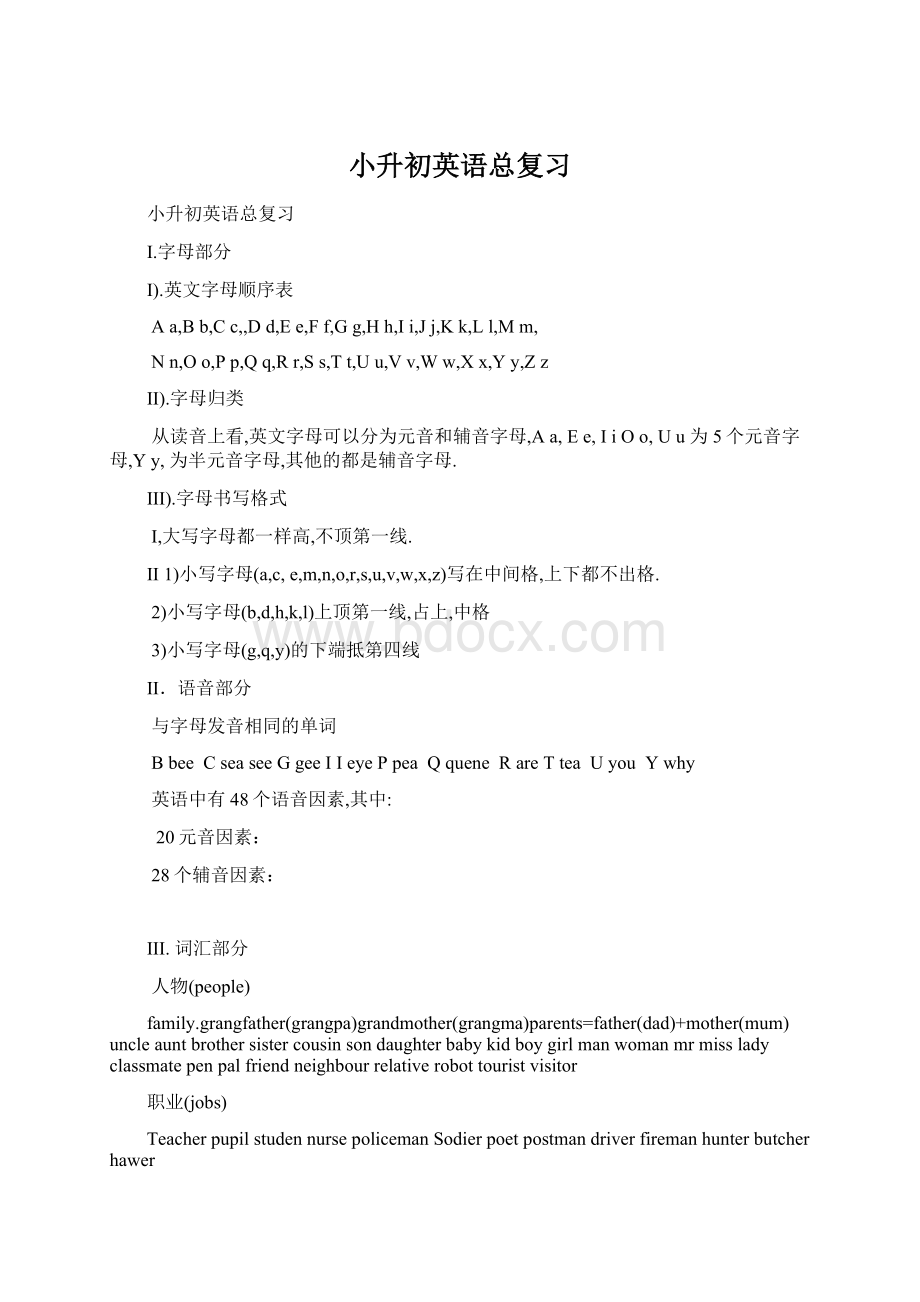小升初英语总复习.docx
《小升初英语总复习.docx》由会员分享,可在线阅读,更多相关《小升初英语总复习.docx(9页珍藏版)》请在冰豆网上搜索。

小升初英语总复习
小升初英语总复习
I.字母部分
I).英文字母顺序表
Aa,Bb,Cc,,Dd,Ee,Ff,Gg,Hh,Ii,Jj,Kk,Ll,Mm,
Nn,Oo,Pp,Qq,Rr,Ss,Tt,Uu,Vv,Ww,Xx,Yy,Zz
II).字母归类
从读音上看,英文字母可以分为元音和辅音字母,Aa,Ee,IiOo,Uu为5个元音字母,Yy,为半元音字母,其他的都是辅音字母.
III).字母书写格式
I,大写字母都一样高,不顶第一线.
II1)小写字母(a,c,e,m,n,o,r,s,u,v,w,x,z)写在中间格,上下都不出格.
2)小写字母(b,d,h,k,l)上顶第一线,占上,中格
3)小写字母(g,q,y)的下端抵第四线
II.语音部分
与字母发音相同的单词
BbeeCseaseeGgeeIIeyePpeaQqueneRareTteaUyouYwhy
英语中有48个语音因素,其中:
20元音因素:
28个辅音因素:
III.词汇部分
人物(people)
family.grangfather(grangpa)grandmother(grangma)parents=father(dad)+mother(mum)uncleauntbrothersistercousinsondaughterbabykidboygirlmanwomanmrmissladyclassmatepenpalfriendneighbourrelativerobottouristvisitor
职业(jobs)
TeacherpupilstudennursepolicemanSodierpoetpostmandriverfiremanhunterbutcherhawer
人体(body)
Headhaireyenoseearmouthtoothneckarmhandfingerkneelegfoot
动物(animals)
Cowpigduckhenmousebirdlionmonkeydogfrogcat猫rabbitpuppywolfbullpetelephanttigerseagullladybird
学习用品(shoolthings)
BagschoolbagbookEnglishbookchinesebookpenpencilpencil-boxsharpenerrulererasergluedictionary
数词(num)
基数词(1-20):
Zeroonetwothreefourfivesixseveneightnineteneleventwelvethirttenfourteenfifteensixteenseventeeneighteennineteentwenty
序数词(第一到第二十):
firstsecondthirdfourthfifthsixthseventheighthninethtentheleventhtwelfththirteenthfourteenthfifteenthsixteenthseventeentheighteenthnineteenthtwentieth
食物饮料(foodsanddrinks)
Mealbreakfastlunchsuuperpicnicricerice-dumplingnoodlecolddrinksoupwaterpepperjamsaltsugarlollipopteasweeteggeggyolkjellynutchocolateice-creammilkcakemooncakebiscuitbreadmeatbeaffishporkmutton
水果蔬菜(fruitandvegetable)
Applepine-applebananaorangemangolemoncarrogrape
气象(weather)
Warmcoolrainwindhotcoldwindycloudysnowysunnyforecast
颜色(colours)
Redpinkblueyellowwhiteorangegreybrown
衣服(clother)
HatscalfjumpercoatshirtT-shirtTraincoatglavesbelttrousersdressswimmingsuitsocksstocking
交通工具(vehicles)
bickbicycleboatcarbusshipsubwayplantraintaxi
课程(courses)
Englishchinesemathmusicscience
月份(months)
(1月-12月)JanuaryFebruaryMarchA-pilMayJuneJulyAugustSeptemberOctoberNovemberDecember
季节(seasons)
Springsummerautumnwinter
星期(week)
(周一至周日)MondayTuesdayWednesdayThursdayFridaySaturdaySundayweekdayweekend
节日(Festival)
SpringFestivalTheDragonBoatFestivalNationalDayChidren'sDayChristmas
房屋家具(house)
Doorbedtablechairwardrobeteapotbenchseatsofastairrooflightlampchimneyslidecupboardscissors
自然(nature)
Bridgelakeskyroadsandstonelandearth
运动(sports)
Metreracefootballbasketballhotdanceskipswimmingswingliondancedragondancroller-blanding
国家(countries)
ChinaCanadaIndiaFranceAmericaEnglishAustralia
地点(locations)
Schoolclassroomclassbookestoreshoppingcentremarketcafecinemalshoppetshoppostofficebankrailwaystationzoomspacemuseumhomegardenkitchenroombedroomlivingroomflatcityvillagestoreroom
名词(noun)
Nameflaghobbystickerstickerstoryalbumphototimetableplanreunionfire-crackertopciondollarpoundyuancamptelevisionbamboopaitingpresentfilmholefieldhornideamedicinephoneagepicturenumbercovermarklibrariannoticesumyesterdaytodaytomorrowcornermatteroutingredpacketticketholidaypianopiehomeworkhouseworkpaintpurse
动词(verb)
Jumprunthrowflymeetknowtouchraisetakecanseeneedlearnkeepselldropcatchwillwon’tstayhaterubkillscoldvisitopencarrypickhidereplywaitfinishhelphitenjoyaskstealsearchpullpastebreakflodwinkburncombturnsignironcollectholdbrushwritebakesweepcookwalkgocomeclimbgivemessguessborrowforgetfeelhavelikefitrememberarriveshoutwavecrybarkmissunderstandtalkshappen
动词词组(verbphrases)
PickupputdownwakeupgoodatfallovertrytonevermindlookforhandinonfootgetupgotobedGestsdonotgoinNomobilephoneNotalkingNofishingNopickingofflowersNospittingNoparking
形容词(adj)
Nicegoodbigbeautifulfinewellkindoldhappyangrysadshyhungrylovelylongshortthinthickcheapdearhardsoftdirtysicknaughtystrangelatemagiclonelyweakworriedlittleheavylightloudersmallerbiggerpleasedfoolishexicitedhugedangerouscleverdiffcultstraightenoughusefulintertetinginterestedsimilarsamemorelessfewerdifferentbetterotherboringfamousuglyemptybusystrongleftrightwrong
疑问词
Whatwhowhenwherehowwhy
方位介词
atinoninfrontofbehindoutsideinsidenearbesideunderabove
IV.要求写词
A名词单数变复数(规则变化)
a.一般情况下,在词尾加-s.apple-apples,cake-cakesmap-maps
b.以-s,-x,-ch,-sh结尾的词,尾加-es.box-boxes,glass-glasses,brush-brushes,
c.辅音字母加-y结尾的词,先变y为i,再加-esfamily-families,baby-babies
d.元音字母加-y结尾的词,直接加-sboy-boys,day-days,key-keys
(不规则变化)
e.特殊变化:
foot-feetman-menwoman-womenmouse-micetooth-teeth
f.单,复数不变:
chinese-chinesejapanese-japanesedeer-deersheep-sheepfish-fish
B.动词的第三人称单数,现在分词,过去式的变化
a.第三人称单数形式:
a).一般情况下,在动词原形后加-s.work-works,run-runs,like-likes
b).以-o,-s,-x,-ch,-sh结尾的动词,加-es.teach-teaches
c).辅音字母加-y结尾的动词,先变y为i,再加-es.try-tries,study-studies
d).以元音字母加-y结尾的动词,直接在后边加-s.stay-stays.play-plays
b现在分词
a).在动词原形后加-ing.catch-catchingdo-doinggo-going
b).以不发音e结尾的动词,先去掉e,再加-ing.write-writing,have-having,give-givingbite-bitingcome-coming
c).以重读闭音节结尾只有一个辅音字母,先双写这个辅音字母后,再加-ing.swim-swimming,run-running,put-puttingsit-sitting
d)少数以ie结尾的动词,先变ie为y,再加ing.die-dying,lie-lying
c词过去式(规则)
a).在动词原形后加-edwork-worked
b).辅音字母加-y结尾的动词,先变y为i,再加-ed..try-tried,study-studied
c).以重读闭音节结尾只有一个辅音字母,先双写这个辅音字母后,再加-edstop-stopped,plan-planned
(不规则的动词过去式)
Put-putgo-wentget-gotcome-camerun-rangive-gavekeep-kepteat-ateshoot-shotbring-broughtcan-couldsit-satmeet-metsay-saidread-readhave-haddo-didsee-sawtake-tookemake-madesing-sangbuy-boughthold-heldfell-feltfall-fellride-rodefly-flew
C.同音异形词归纳
Two-to-tootheir-thereknow-noright-writepair-pearsun-sondear-deerfour-forhair-harewear-whereweek-weak
D.缩略词归纳
a.系动词,助动词与副词的缩写;
isnot=isn’tarenot=aren’thavenot=haven’thasnot=hasn’tdonot=donotdoesnot=doesn’tcannot=can’twillnot=won’t
b.代词与系动词,助动词的缩写
Iam=I’mweare=we’reyouare=you’retheyare=they’reheis/hehas=he’ssheis/shehas=she’sthatis=that’sitis=it’syouhave=you’ve
c.疑问词语系动词的缩写
whois=who’swhatis=what’swhenis=when’showis=how’swhereis=where’s
E.反义词(对应词)归纳
a,名词(noun)
Day-nightboy-girlman-womanmr-mrs
b.动词(verb)
remember-forgettake-bringgo-comecry-laughtopen-closesell-buyborrow-returnstart-stopleave-staylove-hatesit-standask-answerlearn-teachpull-pushfind-lost
c.副词(advb)
yes-nohere-therealways-never
d.(prep)
in-outup-downatfirst-atlast
e.形容词(adj)
more-lesssame-differentleft-right–wrongbeautiful-uglylong-short-tallthin-thickcheap-dearhard-softweak-stronggood-bad.heavy-light.smaller-big.clever-stupidbetter-wosedangerous-saftinterteting-boringearly-latequiet-noisynew-oldfar-neareast-westclean-dirtyhot-coldthis-thatthese-thosequick-slowglad-sadfast-sloweasy-diffcultwarm-coolbright-darknew-old-youngwhite-black
F.形容词,副词的比较级,最高级的构成
a.(有规则构成)
a),一般情况在词尾加-er或-esttall-taller-tallest
b).结尾是-e的词,只加-r或-stlate-later-latest
c).重读闭音节词结尾只有一个辅音字母的先双写这个辅音字母,再加-er或-estbig-bigger-biggestfat-fatter-fattest
d).辅音字母加-y结尾的双音节词,先变y为i,再加-er或estearly-earlier-earliest
e).在多音节词前面加more或most,这些词有:
interestingcarefulimportantbeautifulcarefullyquickly
b.(不规则变化)
good/well-better-best.bad/ill-worse-worstmany/much-more-mostlittle-less-leastfar-farther-farthest
G.形容词变副词
一般情况下,在形容词后面+ly
H代词之间的变换
(主格)——(宾格)(主格)—(宾格)
Imeweus
Youyouyouyou
HehimSheher
Itittheythem
(物主)——(名词性)(物主)——(名词性)
mymineourours
youryoursyouryours
hishisherhers
itsitstheirtheirs
V.对画线部分提问:
(画线的部分是什么成分就对什么提
对人物提问用;who
对地点提问用;where
对事物名称提问用;what
时间提问用;when/whattime
对星期提问用;whatday
对日期提问用;what’sthedate
对颜色提问用;whatcolour
对年级提问用;whatgrade
对班级提问用;whatclass
对职业提问用;whatdo(does)sbdo?
对原因提问用:
why
对(交通)方式提问用;how
对数量提问用;howmany(可数名词)
howmuch(不可数名词)
对价格提问用;howmuch
对年龄提问用;howold
对重量提问用;howheavy
对高度提问用;howtall
V.句形转换
A.陈述句转换成否定句:
a.如果陈述句中谓语动词是Be动词(am.is.are.was.were),或谓语动词含助动词(do.does.did)情态动词(can,could.may.must),只在它们后加not即可
b.如果have在句子中是助动词,没有任何意思时,直接在它后面加not即可.当它作“吃,喝,有”时,在该谓语动词前加don’t.doesn’t或didn’t来构成否定式
c.如果陈述句句中谓语动词是实义动词,而其中又没有情态动词或助动词时,在该谓语动词前加don’t.doesn’t或didn’t来构成否定式
B.陈述句转换成疑问句
a.如果陈述句中谓语动词含有“移动词”(be动词,助动词,或情态动词).可用此法:
一调:
将句中的“可移动词”调到句首,
二改:
将调出来的动词的首字母改为大写,原来句首动词的大写改为小写(除规定的以外)
三问号:
即在句末句号改为问号.
b.如果陈述句中谓语动词没有“可移动词”,则采用:
一加:
在句首加Do,Does.Did
二改:
将原句中的大写改为小写(除规定的以外),谓语动词还原
三问号.即在句末句号改为问号
VII.时态转换
A一般现在时;
概念;表示经常发生的动作
句式结构:
主语+动词原形+其他成分
主语(第三人称单数)+动词第三人称单数+其他成分
用法:
它常与下列副词或时间状语连用:
always,often,usually,everyday,
B,现在进行时
概念;表示现在正在发生的动作
句式结构:
主语+动词Be+现在分词(-ing形式)+其他成分
用法:
助动词Be应随人称的变化而变化。
Iam,youarehe/she/itiswe/theyare.现在进行时常与时间状语now,amonent连用
C.过去进行时
概念;表示过去某个时间发生的动作或存在的状态
句式结构:
主语+过去分词(-ed形式)+其他成分
用法:
常与时间状语tomorrow.Thismorning.lastweek/month/year.justnow连用
D.一般将来时
概念;表示将来某个时间要发生的动作或存在的状态
句式结构:
主语+will/shall+动词原形+其他成分
用法:
will,shall和begoingto都表示将来时。
一般与将来时连用的时间状语有inthefuture,tomorrow,nextweek/year,